SBM4301 - Uber vs Taxi: A War of Innovative & Technological Standards
VerifiedAdded on 2023/06/09
|17
|4174
|138
Report
AI Summary
This report examines the competition between Uber and traditional taxi services, focusing on the impact of innovative and technological standards. It applies the double-diamond design thinking model to analyze the problem, define potential solutions, and create a sustainable platform that integrates the features of both Uber and traditional taxi models. The report discusses the scalability of the proposed platform, its impact on the taxi industry and community, and potential difficulties in implementation. The analysis considers Uber's disruptive influence, the regulatory challenges faced by traditional taxi companies, and the potential for a unified platform to offer consumers the benefits of both models. The report concludes by emphasizing the importance of integrating innovation with established service quality to achieve a balanced and sustainable transportation ecosystem.
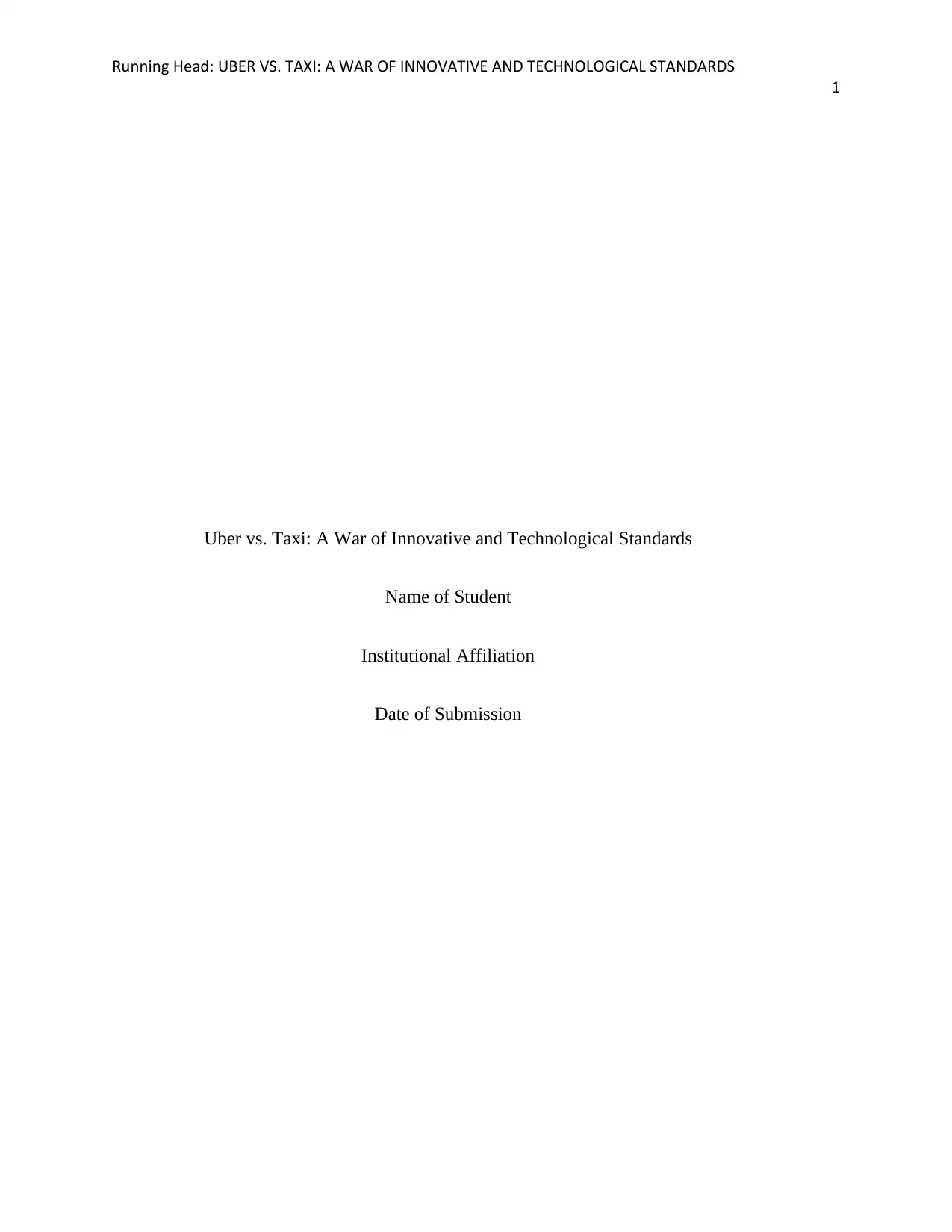
Running Head: UBER VS. TAXI: A WAR OF INNOVATIVE AND TECHNOLOGICAL STANDARDS
1
Uber vs. Taxi: A War of Innovative and Technological Standards
Name of Student
Institutional Affiliation
Date of Submission
1
Uber vs. Taxi: A War of Innovative and Technological Standards
Name of Student
Institutional Affiliation
Date of Submission
Paraphrase This Document
Need a fresh take? Get an instant paraphrase of this document with our AI Paraphraser

UBER VS. TAXI: A WAR OF INNOVATOVE AND TECHNOLOGICAL STANDARDS
2
Table of contents
Abstract........................................................................................................................................................3
Introduction..................................................................................................................................................4
The Design Thinking Model Applied..........................................................................................................7
The Double-diamond Design Thinking Model........................................................................................7
Understanding the Problem.................................................................................................................8
Defining the Problem...........................................................................................................................8
Exploring the Potential Solutions........................................................................................................8
Creating the Solution...........................................................................................................................9
Sustainability of the Solution.......................................................................................................................9
Measuring the Effectiveness of the Suggested Solution............................................................................11
Scalability of the Proposed Platform.....................................................................................................11
The Impact of the Platform to the General Taxi Industry.....................................................................11
The Impact of the Proposed Model to the Industry Producers..............................................................11
Effects to the Community......................................................................................................................12
Potential Difficulties of the Proposed Platform.........................................................................................12
References..................................................................................................................................................14
2
Table of contents
Abstract........................................................................................................................................................3
Introduction..................................................................................................................................................4
The Design Thinking Model Applied..........................................................................................................7
The Double-diamond Design Thinking Model........................................................................................7
Understanding the Problem.................................................................................................................8
Defining the Problem...........................................................................................................................8
Exploring the Potential Solutions........................................................................................................8
Creating the Solution...........................................................................................................................9
Sustainability of the Solution.......................................................................................................................9
Measuring the Effectiveness of the Suggested Solution............................................................................11
Scalability of the Proposed Platform.....................................................................................................11
The Impact of the Platform to the General Taxi Industry.....................................................................11
The Impact of the Proposed Model to the Industry Producers..............................................................11
Effects to the Community......................................................................................................................12
Potential Difficulties of the Proposed Platform.........................................................................................12
References..................................................................................................................................................14

UBER VS. TAXI: A WAR OF INNOVATOVE AND TECHNOLOGICAL STANDARDS
3
Abstract
Ridesharing is an emergent form of point to point commutation. Businesses such as Uber,
13 cabs, and Lyft run their operations whereby drivers who offer their own vehicles are matched
with commuters who seeking to travel (Meleen & Frenken, 2015). The impacts of this disruptive
innovation are far reaching and thus the need to find the perfect balance for the functioning of
both the new and old model of business operations in the taxi industry (Bocker & Meelen, 2017).
Operations of the Uber online platform began officially in Australia in April 2014. Since
then, the company’s operations have expanded from Sydney and Melbourne, where they began,
to other cities such as Perth, Brisbane, Canberra and Gold Coast. The assessment of the impact
of this emergent and disruptive innovation is essential since the effects are far-reaching and
affect numerous key industry stakeholders (Deloitte Access Economics, 2016).
3
Abstract
Ridesharing is an emergent form of point to point commutation. Businesses such as Uber,
13 cabs, and Lyft run their operations whereby drivers who offer their own vehicles are matched
with commuters who seeking to travel (Meleen & Frenken, 2015). The impacts of this disruptive
innovation are far reaching and thus the need to find the perfect balance for the functioning of
both the new and old model of business operations in the taxi industry (Bocker & Meelen, 2017).
Operations of the Uber online platform began officially in Australia in April 2014. Since
then, the company’s operations have expanded from Sydney and Melbourne, where they began,
to other cities such as Perth, Brisbane, Canberra and Gold Coast. The assessment of the impact
of this emergent and disruptive innovation is essential since the effects are far-reaching and
affect numerous key industry stakeholders (Deloitte Access Economics, 2016).
⊘ This is a preview!⊘
Do you want full access?
Subscribe today to unlock all pages.

Trusted by 1+ million students worldwide
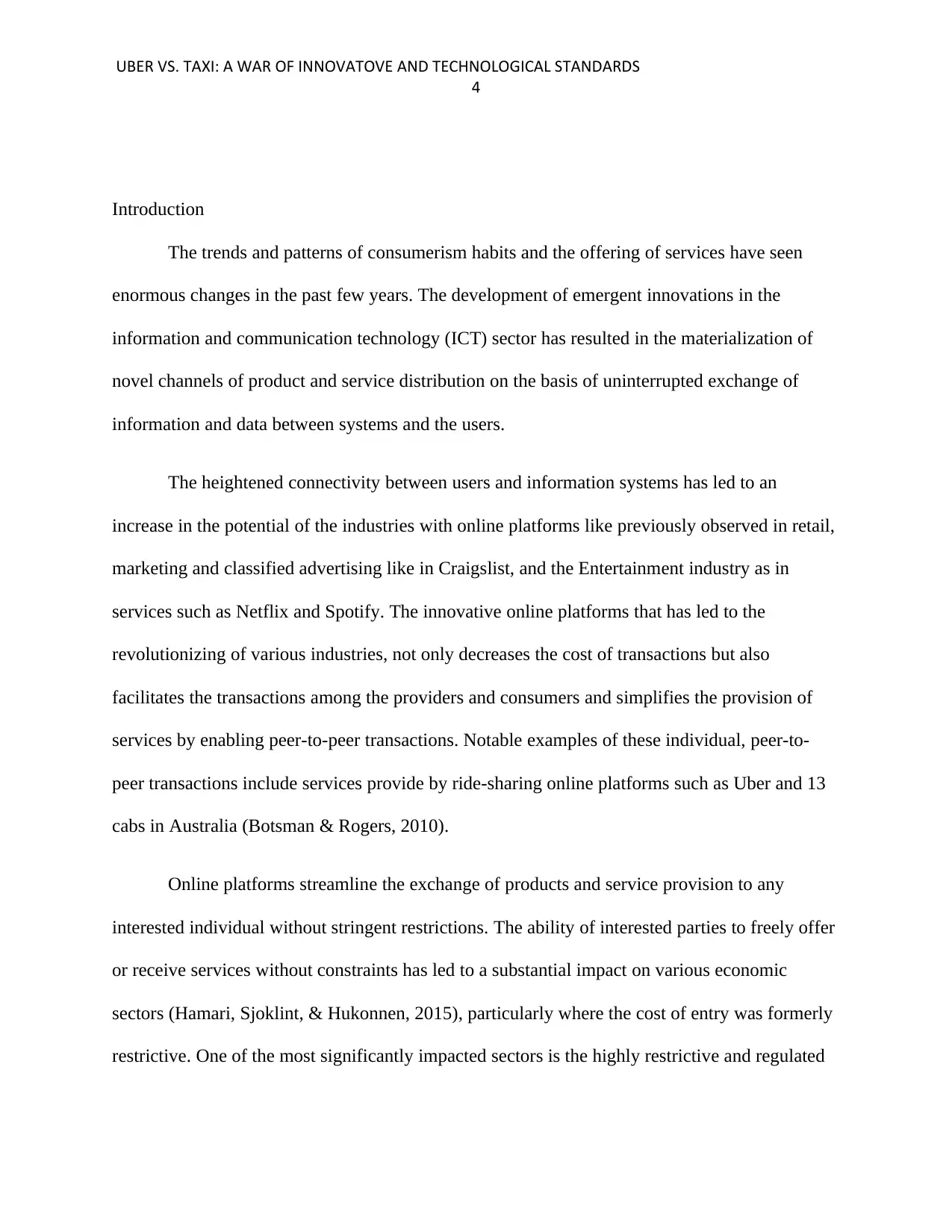
UBER VS. TAXI: A WAR OF INNOVATOVE AND TECHNOLOGICAL STANDARDS
4
Introduction
The trends and patterns of consumerism habits and the offering of services have seen
enormous changes in the past few years. The development of emergent innovations in the
information and communication technology (ICT) sector has resulted in the materialization of
novel channels of product and service distribution on the basis of uninterrupted exchange of
information and data between systems and the users.
The heightened connectivity between users and information systems has led to an
increase in the potential of the industries with online platforms like previously observed in retail,
marketing and classified advertising like in Craigslist, and the Entertainment industry as in
services such as Netflix and Spotify. The innovative online platforms that has led to the
revolutionizing of various industries, not only decreases the cost of transactions but also
facilitates the transactions among the providers and consumers and simplifies the provision of
services by enabling peer-to-peer transactions. Notable examples of these individual, peer-to-
peer transactions include services provide by ride-sharing online platforms such as Uber and 13
cabs in Australia (Botsman & Rogers, 2010).
Online platforms streamline the exchange of products and service provision to any
interested individual without stringent restrictions. The ability of interested parties to freely offer
or receive services without constraints has led to a substantial impact on various economic
sectors (Hamari, Sjoklint, & Hukonnen, 2015), particularly where the cost of entry was formerly
restrictive. One of the most significantly impacted sectors is the highly restrictive and regulated
4
Introduction
The trends and patterns of consumerism habits and the offering of services have seen
enormous changes in the past few years. The development of emergent innovations in the
information and communication technology (ICT) sector has resulted in the materialization of
novel channels of product and service distribution on the basis of uninterrupted exchange of
information and data between systems and the users.
The heightened connectivity between users and information systems has led to an
increase in the potential of the industries with online platforms like previously observed in retail,
marketing and classified advertising like in Craigslist, and the Entertainment industry as in
services such as Netflix and Spotify. The innovative online platforms that has led to the
revolutionizing of various industries, not only decreases the cost of transactions but also
facilitates the transactions among the providers and consumers and simplifies the provision of
services by enabling peer-to-peer transactions. Notable examples of these individual, peer-to-
peer transactions include services provide by ride-sharing online platforms such as Uber and 13
cabs in Australia (Botsman & Rogers, 2010).
Online platforms streamline the exchange of products and service provision to any
interested individual without stringent restrictions. The ability of interested parties to freely offer
or receive services without constraints has led to a substantial impact on various economic
sectors (Hamari, Sjoklint, & Hukonnen, 2015), particularly where the cost of entry was formerly
restrictive. One of the most significantly impacted sectors is the highly restrictive and regulated
Paraphrase This Document
Need a fresh take? Get an instant paraphrase of this document with our AI Paraphraser
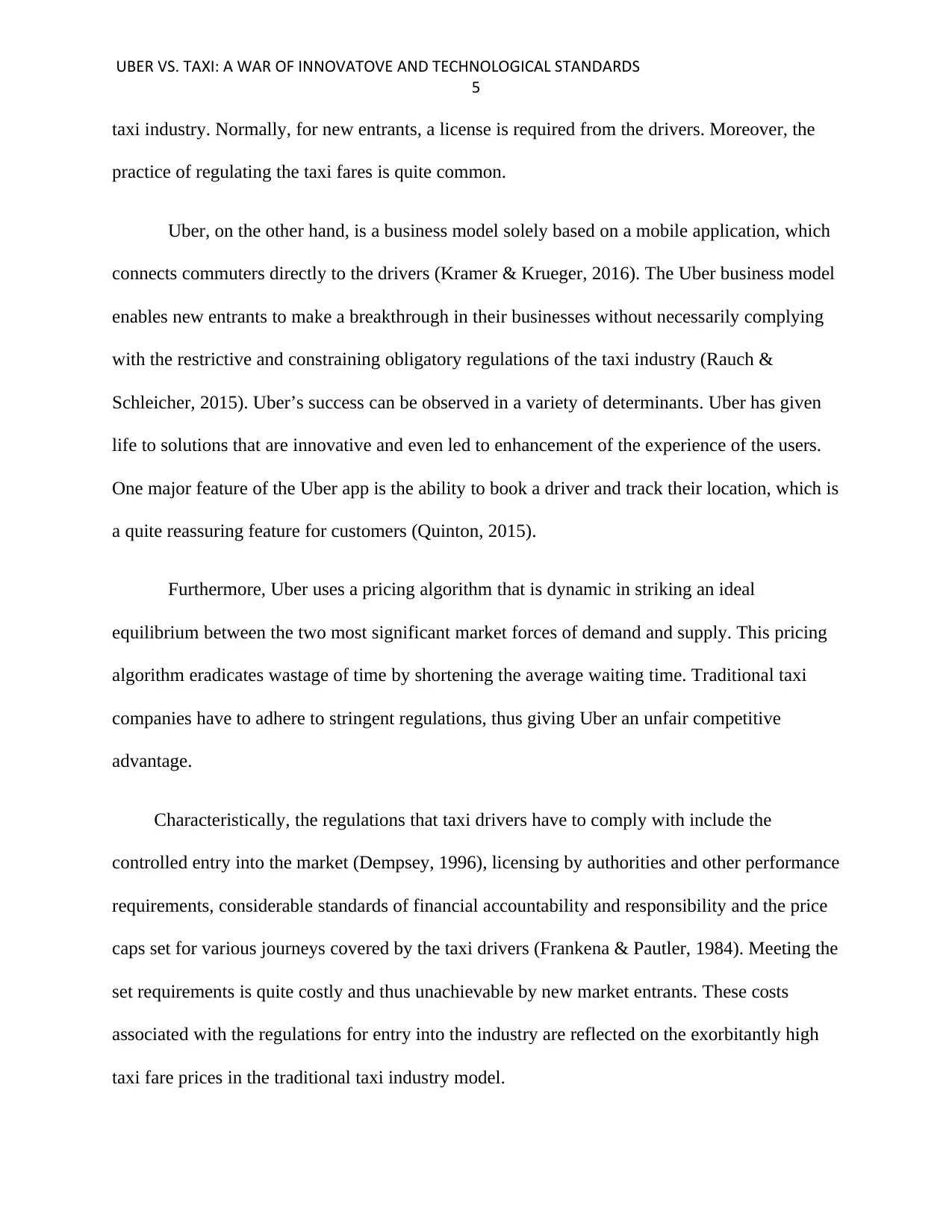
UBER VS. TAXI: A WAR OF INNOVATOVE AND TECHNOLOGICAL STANDARDS
5
taxi industry. Normally, for new entrants, a license is required from the drivers. Moreover, the
practice of regulating the taxi fares is quite common.
Uber, on the other hand, is a business model solely based on a mobile application, which
connects commuters directly to the drivers (Kramer & Krueger, 2016). The Uber business model
enables new entrants to make a breakthrough in their businesses without necessarily complying
with the restrictive and constraining obligatory regulations of the taxi industry (Rauch &
Schleicher, 2015). Uber’s success can be observed in a variety of determinants. Uber has given
life to solutions that are innovative and even led to enhancement of the experience of the users.
One major feature of the Uber app is the ability to book a driver and track their location, which is
a quite reassuring feature for customers (Quinton, 2015).
Furthermore, Uber uses a pricing algorithm that is dynamic in striking an ideal
equilibrium between the two most significant market forces of demand and supply. This pricing
algorithm eradicates wastage of time by shortening the average waiting time. Traditional taxi
companies have to adhere to stringent regulations, thus giving Uber an unfair competitive
advantage.
Characteristically, the regulations that taxi drivers have to comply with include the
controlled entry into the market (Dempsey, 1996), licensing by authorities and other performance
requirements, considerable standards of financial accountability and responsibility and the price
caps set for various journeys covered by the taxi drivers (Frankena & Pautler, 1984). Meeting the
set requirements is quite costly and thus unachievable by new market entrants. These costs
associated with the regulations for entry into the industry are reflected on the exorbitantly high
taxi fare prices in the traditional taxi industry model.
5
taxi industry. Normally, for new entrants, a license is required from the drivers. Moreover, the
practice of regulating the taxi fares is quite common.
Uber, on the other hand, is a business model solely based on a mobile application, which
connects commuters directly to the drivers (Kramer & Krueger, 2016). The Uber business model
enables new entrants to make a breakthrough in their businesses without necessarily complying
with the restrictive and constraining obligatory regulations of the taxi industry (Rauch &
Schleicher, 2015). Uber’s success can be observed in a variety of determinants. Uber has given
life to solutions that are innovative and even led to enhancement of the experience of the users.
One major feature of the Uber app is the ability to book a driver and track their location, which is
a quite reassuring feature for customers (Quinton, 2015).
Furthermore, Uber uses a pricing algorithm that is dynamic in striking an ideal
equilibrium between the two most significant market forces of demand and supply. This pricing
algorithm eradicates wastage of time by shortening the average waiting time. Traditional taxi
companies have to adhere to stringent regulations, thus giving Uber an unfair competitive
advantage.
Characteristically, the regulations that taxi drivers have to comply with include the
controlled entry into the market (Dempsey, 1996), licensing by authorities and other performance
requirements, considerable standards of financial accountability and responsibility and the price
caps set for various journeys covered by the taxi drivers (Frankena & Pautler, 1984). Meeting the
set requirements is quite costly and thus unachievable by new market entrants. These costs
associated with the regulations for entry into the industry are reflected on the exorbitantly high
taxi fare prices in the traditional taxi industry model.
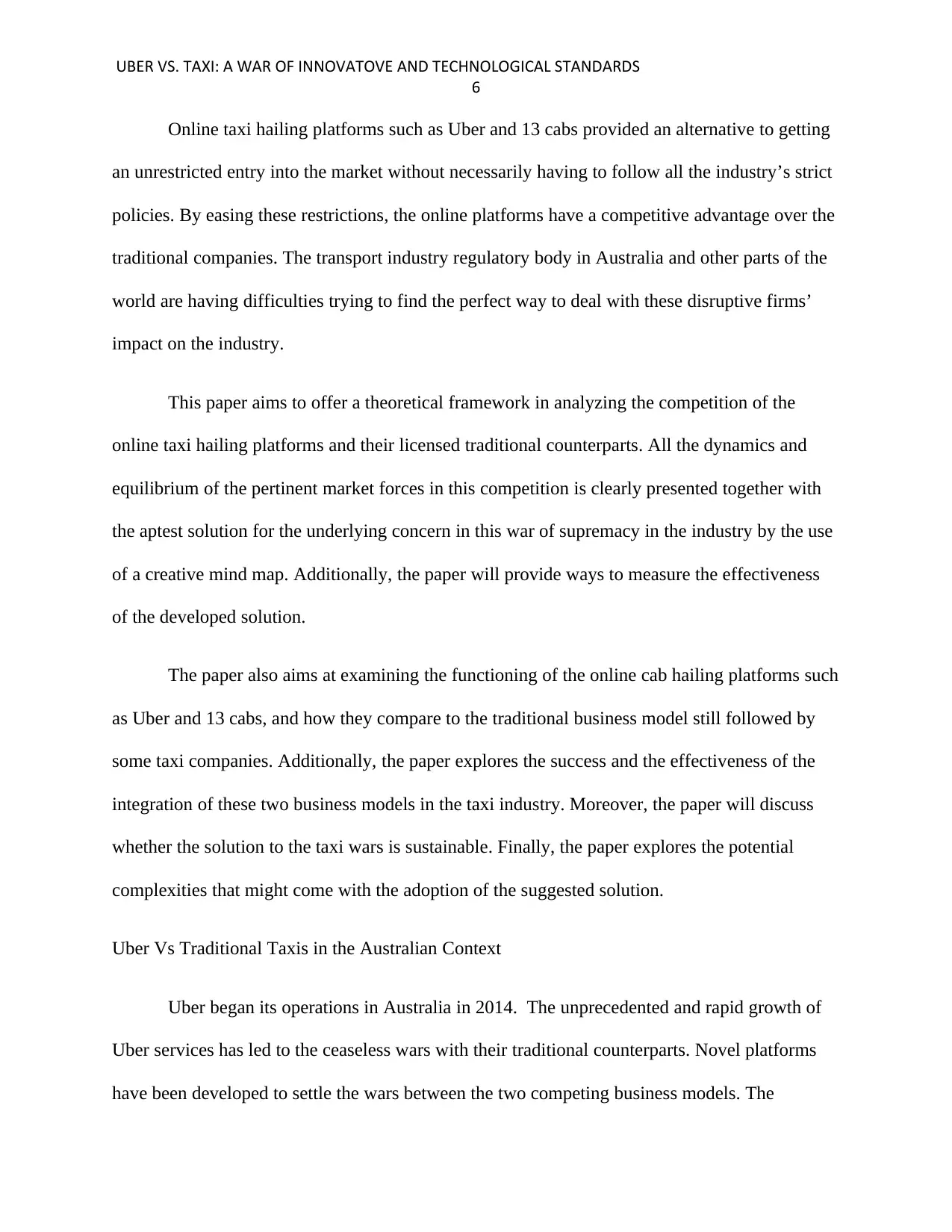
UBER VS. TAXI: A WAR OF INNOVATOVE AND TECHNOLOGICAL STANDARDS
6
Online taxi hailing platforms such as Uber and 13 cabs provided an alternative to getting
an unrestricted entry into the market without necessarily having to follow all the industry’s strict
policies. By easing these restrictions, the online platforms have a competitive advantage over the
traditional companies. The transport industry regulatory body in Australia and other parts of the
world are having difficulties trying to find the perfect way to deal with these disruptive firms’
impact on the industry.
This paper aims to offer a theoretical framework in analyzing the competition of the
online taxi hailing platforms and their licensed traditional counterparts. All the dynamics and
equilibrium of the pertinent market forces in this competition is clearly presented together with
the aptest solution for the underlying concern in this war of supremacy in the industry by the use
of a creative mind map. Additionally, the paper will provide ways to measure the effectiveness
of the developed solution.
The paper also aims at examining the functioning of the online cab hailing platforms such
as Uber and 13 cabs, and how they compare to the traditional business model still followed by
some taxi companies. Additionally, the paper explores the success and the effectiveness of the
integration of these two business models in the taxi industry. Moreover, the paper will discuss
whether the solution to the taxi wars is sustainable. Finally, the paper explores the potential
complexities that might come with the adoption of the suggested solution.
Uber Vs Traditional Taxis in the Australian Context
Uber began its operations in Australia in 2014. The unprecedented and rapid growth of
Uber services has led to the ceaseless wars with their traditional counterparts. Novel platforms
have been developed to settle the wars between the two competing business models. The
6
Online taxi hailing platforms such as Uber and 13 cabs provided an alternative to getting
an unrestricted entry into the market without necessarily having to follow all the industry’s strict
policies. By easing these restrictions, the online platforms have a competitive advantage over the
traditional companies. The transport industry regulatory body in Australia and other parts of the
world are having difficulties trying to find the perfect way to deal with these disruptive firms’
impact on the industry.
This paper aims to offer a theoretical framework in analyzing the competition of the
online taxi hailing platforms and their licensed traditional counterparts. All the dynamics and
equilibrium of the pertinent market forces in this competition is clearly presented together with
the aptest solution for the underlying concern in this war of supremacy in the industry by the use
of a creative mind map. Additionally, the paper will provide ways to measure the effectiveness
of the developed solution.
The paper also aims at examining the functioning of the online cab hailing platforms such
as Uber and 13 cabs, and how they compare to the traditional business model still followed by
some taxi companies. Additionally, the paper explores the success and the effectiveness of the
integration of these two business models in the taxi industry. Moreover, the paper will discuss
whether the solution to the taxi wars is sustainable. Finally, the paper explores the potential
complexities that might come with the adoption of the suggested solution.
Uber Vs Traditional Taxis in the Australian Context
Uber began its operations in Australia in 2014. The unprecedented and rapid growth of
Uber services has led to the ceaseless wars with their traditional counterparts. Novel platforms
have been developed to settle the wars between the two competing business models. The
⊘ This is a preview!⊘
Do you want full access?
Subscribe today to unlock all pages.

Trusted by 1+ million students worldwide
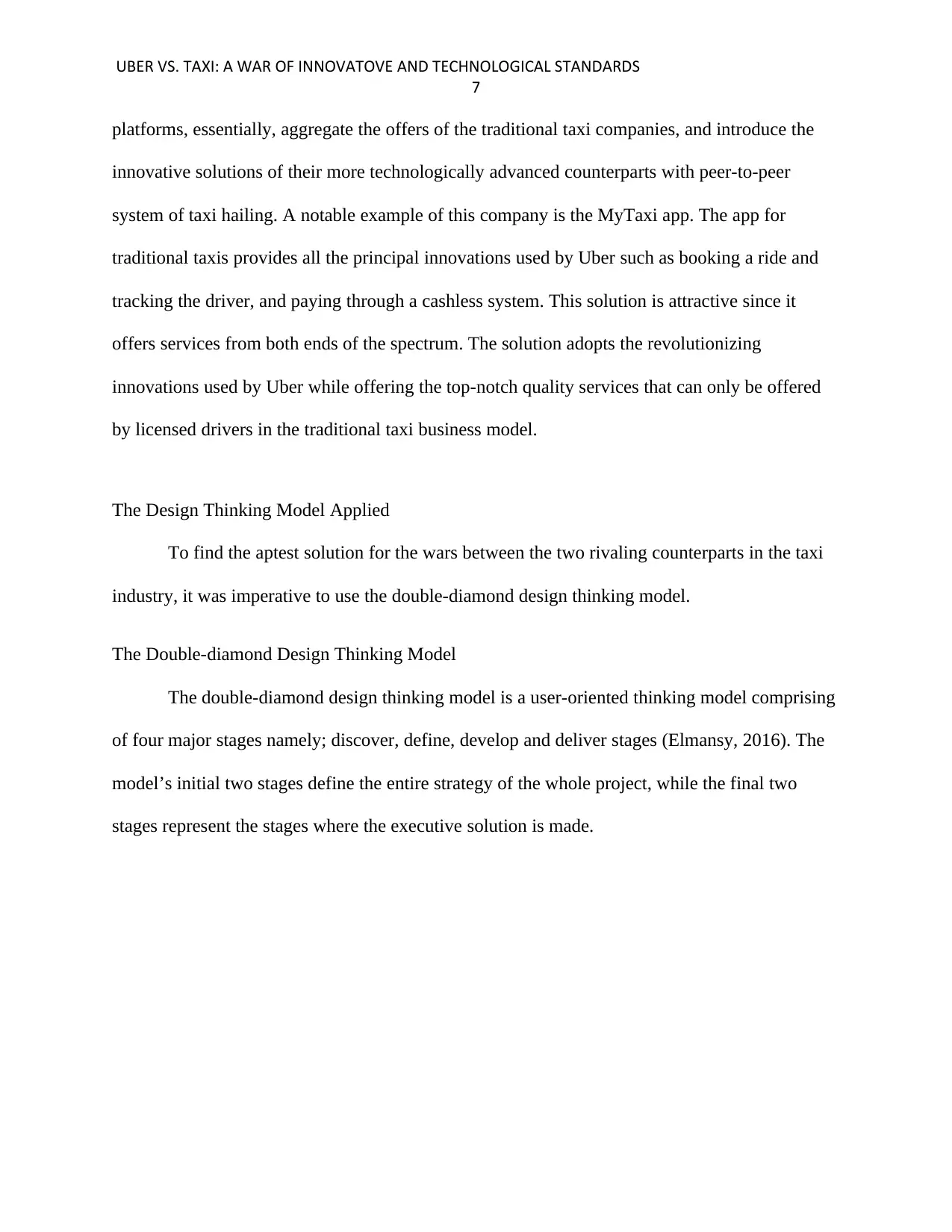
UBER VS. TAXI: A WAR OF INNOVATOVE AND TECHNOLOGICAL STANDARDS
7
platforms, essentially, aggregate the offers of the traditional taxi companies, and introduce the
innovative solutions of their more technologically advanced counterparts with peer-to-peer
system of taxi hailing. A notable example of this company is the MyTaxi app. The app for
traditional taxis provides all the principal innovations used by Uber such as booking a ride and
tracking the driver, and paying through a cashless system. This solution is attractive since it
offers services from both ends of the spectrum. The solution adopts the revolutionizing
innovations used by Uber while offering the top-notch quality services that can only be offered
by licensed drivers in the traditional taxi business model.
The Design Thinking Model Applied
To find the aptest solution for the wars between the two rivaling counterparts in the taxi
industry, it was imperative to use the double-diamond design thinking model.
The Double-diamond Design Thinking Model
The double-diamond design thinking model is a user-oriented thinking model comprising
of four major stages namely; discover, define, develop and deliver stages (Elmansy, 2016). The
model’s initial two stages define the entire strategy of the whole project, while the final two
stages represent the stages where the executive solution is made.
7
platforms, essentially, aggregate the offers of the traditional taxi companies, and introduce the
innovative solutions of their more technologically advanced counterparts with peer-to-peer
system of taxi hailing. A notable example of this company is the MyTaxi app. The app for
traditional taxis provides all the principal innovations used by Uber such as booking a ride and
tracking the driver, and paying through a cashless system. This solution is attractive since it
offers services from both ends of the spectrum. The solution adopts the revolutionizing
innovations used by Uber while offering the top-notch quality services that can only be offered
by licensed drivers in the traditional taxi business model.
The Design Thinking Model Applied
To find the aptest solution for the wars between the two rivaling counterparts in the taxi
industry, it was imperative to use the double-diamond design thinking model.
The Double-diamond Design Thinking Model
The double-diamond design thinking model is a user-oriented thinking model comprising
of four major stages namely; discover, define, develop and deliver stages (Elmansy, 2016). The
model’s initial two stages define the entire strategy of the whole project, while the final two
stages represent the stages where the executive solution is made.
Paraphrase This Document
Need a fresh take? Get an instant paraphrase of this document with our AI Paraphraser

UBER VS. TAXI: A WAR OF INNOVATOVE AND TECHNOLOGICAL STANDARDS
8
The double-diamond thinking design aids in mapping the diverging and the converging
stages of a design process in problem solving (Schneider, 2015). The model makes a description
of the aptest and the most significant design up-front. Due to the models design in problem
solving, the solutions are adequately test before they are released to the public. This design
ensures that the solutions are flawless before they are released for the public to use.
In finding the solution to the war between the rivaling counterparts in the taxi industry,
the following process was followed.
Understanding the Problem
The process begins with understanding the trigger of the problem. This includes but is not
limited to factors such as a macro-economic shift, an innovative idea or generally any change in
the industry. In this case of the rivaling taxi industry players, the problem was triggered by an
innovative idea that consequently led to a change in the trends and the consumption behavior of
customers in the market.
8
The double-diamond thinking design aids in mapping the diverging and the converging
stages of a design process in problem solving (Schneider, 2015). The model makes a description
of the aptest and the most significant design up-front. Due to the models design in problem
solving, the solutions are adequately test before they are released to the public. This design
ensures that the solutions are flawless before they are released for the public to use.
In finding the solution to the war between the rivaling counterparts in the taxi industry,
the following process was followed.
Understanding the Problem
The process begins with understanding the trigger of the problem. This includes but is not
limited to factors such as a macro-economic shift, an innovative idea or generally any change in
the industry. In this case of the rivaling taxi industry players, the problem was triggered by an
innovative idea that consequently led to a change in the trends and the consumption behavior of
customers in the market.

UBER VS. TAXI: A WAR OF INNOVATOVE AND TECHNOLOGICAL STANDARDS
9
Defining the Problem
After comprehending the major trigger of the problem, we synthesized the acquired
information and knowledge on how to effectively deal with it. When defining the problem, we
put emphasis on the most compelling options of the possible solutions. The solution was only
reached after a thorough assessment of the viability and the effect of the chosen plan, and
figuring out the aptest way to measure the success of the solution after implementation.
Exploring the Potential Solutions
After defining the problem and getting the aptest vision in place, all the potential
solutions to the problems were explored keenly and in detail. At this point, the major goal and
what was needed to be achieved to get there were clear. By the exploration of all possible options
and finding validations to the prospective ones, the best way to implement the solution was
achieved. The activity of going through all the potential solutions to find the right solution was
rather iterative and divergent.
Creating the Solution
After exploration and gaining enough confidence in the solution, the process proceeds to
the engineering stage. In this case, the engineering stage involved the development of the
integrated platform that brought together all the useful features and functionalities of Uber and
the customer-oriented service provision model of the traditional taxi business. Here, the software
that would be required in achieving the required solution is created and optimized. The stage is
essentially, two-fold. The first part is the creation of the working solution and releasing to the
market as the feedback from the market is collected. Subsequently, the understanding of the
problem and how to configure the software for optimal results deepens.
9
Defining the Problem
After comprehending the major trigger of the problem, we synthesized the acquired
information and knowledge on how to effectively deal with it. When defining the problem, we
put emphasis on the most compelling options of the possible solutions. The solution was only
reached after a thorough assessment of the viability and the effect of the chosen plan, and
figuring out the aptest way to measure the success of the solution after implementation.
Exploring the Potential Solutions
After defining the problem and getting the aptest vision in place, all the potential
solutions to the problems were explored keenly and in detail. At this point, the major goal and
what was needed to be achieved to get there were clear. By the exploration of all possible options
and finding validations to the prospective ones, the best way to implement the solution was
achieved. The activity of going through all the potential solutions to find the right solution was
rather iterative and divergent.
Creating the Solution
After exploration and gaining enough confidence in the solution, the process proceeds to
the engineering stage. In this case, the engineering stage involved the development of the
integrated platform that brought together all the useful features and functionalities of Uber and
the customer-oriented service provision model of the traditional taxi business. Here, the software
that would be required in achieving the required solution is created and optimized. The stage is
essentially, two-fold. The first part is the creation of the working solution and releasing to the
market as the feedback from the market is collected. Subsequently, the understanding of the
problem and how to configure the software for optimal results deepens.
⊘ This is a preview!⊘
Do you want full access?
Subscribe today to unlock all pages.

Trusted by 1+ million students worldwide

UBER VS. TAXI: A WAR OF INNOVATOVE AND TECHNOLOGICAL STANDARDS
10
Sustainability of the Solution
A brief analysis of the two business models reveals that; Uber and other taxi hailing
companies with online platforms enable direct peer-to-peer (individual) transactions by
connecting the two ends of the market: the commuters and drivers. The two parties connect and
interact solely through the Uber app. The fares are set by the app’s algorithm, which takes into
consideration the base fee and the varying fares that depend on the distance and the length
travelled (Uber, 2017). The fare is then paid to Uber which then forwards the payment to the
driver. Basically, Uber provides the requisite IT infrastructure in this transaction.
By developing this solution of integrating Uber’s functionality and features, with the
high-quality services offered by the traditional taxi drivers, the platform operates on dual and
multi-sided market for customers who prefer either of the above options. The platform facilitates
interactions among multiple distinct and generally interdependent user groups of the taxi
services. This subsequently leads to value generation for both groups (Downes, 2013). The two
different sides are provided with a more integrated platform which capturing the economic value
of their relationship (Evans & Schmalensee, 2007).
Platforms are highly dependent on the external factors. This implies that, an increment in
the elements in the network leads a proportional increase in the network value to the individual
user (Rochet & Tirole, 2003). Even though the increase in the number of users holds a positive
external impact to the incumbent network elements, it also holds negative external impacts to the
rivaling network (Elsner et al., 2014). Therefore, the integration of two rivaling networks in the
same industry diminishes the negative effects while amplifying the positive impacts. Passengers
will certainly choose to hail a taxi in a platform that has more drivers so as to raise the likelihood
of obtaining top-notch services at affordable prices. Drivers will also choose to work with a
10
Sustainability of the Solution
A brief analysis of the two business models reveals that; Uber and other taxi hailing
companies with online platforms enable direct peer-to-peer (individual) transactions by
connecting the two ends of the market: the commuters and drivers. The two parties connect and
interact solely through the Uber app. The fares are set by the app’s algorithm, which takes into
consideration the base fee and the varying fares that depend on the distance and the length
travelled (Uber, 2017). The fare is then paid to Uber which then forwards the payment to the
driver. Basically, Uber provides the requisite IT infrastructure in this transaction.
By developing this solution of integrating Uber’s functionality and features, with the
high-quality services offered by the traditional taxi drivers, the platform operates on dual and
multi-sided market for customers who prefer either of the above options. The platform facilitates
interactions among multiple distinct and generally interdependent user groups of the taxi
services. This subsequently leads to value generation for both groups (Downes, 2013). The two
different sides are provided with a more integrated platform which capturing the economic value
of their relationship (Evans & Schmalensee, 2007).
Platforms are highly dependent on the external factors. This implies that, an increment in
the elements in the network leads a proportional increase in the network value to the individual
user (Rochet & Tirole, 2003). Even though the increase in the number of users holds a positive
external impact to the incumbent network elements, it also holds negative external impacts to the
rivaling network (Elsner et al., 2014). Therefore, the integration of two rivaling networks in the
same industry diminishes the negative effects while amplifying the positive impacts. Passengers
will certainly choose to hail a taxi in a platform that has more drivers so as to raise the likelihood
of obtaining top-notch services at affordable prices. Drivers will also choose to work with a
Paraphrase This Document
Need a fresh take? Get an instant paraphrase of this document with our AI Paraphraser
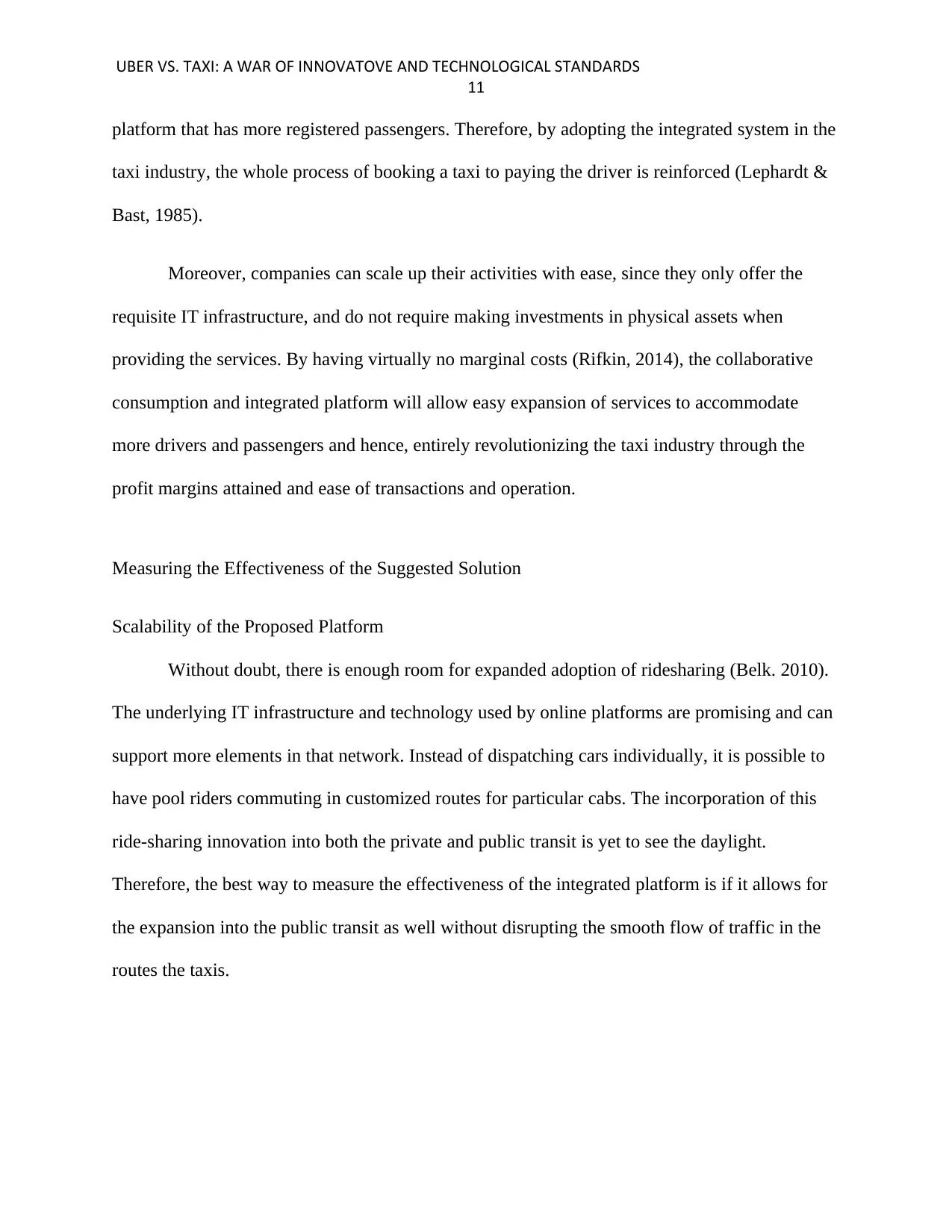
UBER VS. TAXI: A WAR OF INNOVATOVE AND TECHNOLOGICAL STANDARDS
11
platform that has more registered passengers. Therefore, by adopting the integrated system in the
taxi industry, the whole process of booking a taxi to paying the driver is reinforced (Lephardt &
Bast, 1985).
Moreover, companies can scale up their activities with ease, since they only offer the
requisite IT infrastructure, and do not require making investments in physical assets when
providing the services. By having virtually no marginal costs (Rifkin, 2014), the collaborative
consumption and integrated platform will allow easy expansion of services to accommodate
more drivers and passengers and hence, entirely revolutionizing the taxi industry through the
profit margins attained and ease of transactions and operation.
Measuring the Effectiveness of the Suggested Solution
Scalability of the Proposed Platform
Without doubt, there is enough room for expanded adoption of ridesharing (Belk. 2010).
The underlying IT infrastructure and technology used by online platforms are promising and can
support more elements in that network. Instead of dispatching cars individually, it is possible to
have pool riders commuting in customized routes for particular cabs. The incorporation of this
ride-sharing innovation into both the private and public transit is yet to see the daylight.
Therefore, the best way to measure the effectiveness of the integrated platform is if it allows for
the expansion into the public transit as well without disrupting the smooth flow of traffic in the
routes the taxis.
11
platform that has more registered passengers. Therefore, by adopting the integrated system in the
taxi industry, the whole process of booking a taxi to paying the driver is reinforced (Lephardt &
Bast, 1985).
Moreover, companies can scale up their activities with ease, since they only offer the
requisite IT infrastructure, and do not require making investments in physical assets when
providing the services. By having virtually no marginal costs (Rifkin, 2014), the collaborative
consumption and integrated platform will allow easy expansion of services to accommodate
more drivers and passengers and hence, entirely revolutionizing the taxi industry through the
profit margins attained and ease of transactions and operation.
Measuring the Effectiveness of the Suggested Solution
Scalability of the Proposed Platform
Without doubt, there is enough room for expanded adoption of ridesharing (Belk. 2010).
The underlying IT infrastructure and technology used by online platforms are promising and can
support more elements in that network. Instead of dispatching cars individually, it is possible to
have pool riders commuting in customized routes for particular cabs. The incorporation of this
ride-sharing innovation into both the private and public transit is yet to see the daylight.
Therefore, the best way to measure the effectiveness of the integrated platform is if it allows for
the expansion into the public transit as well without disrupting the smooth flow of traffic in the
routes the taxis.
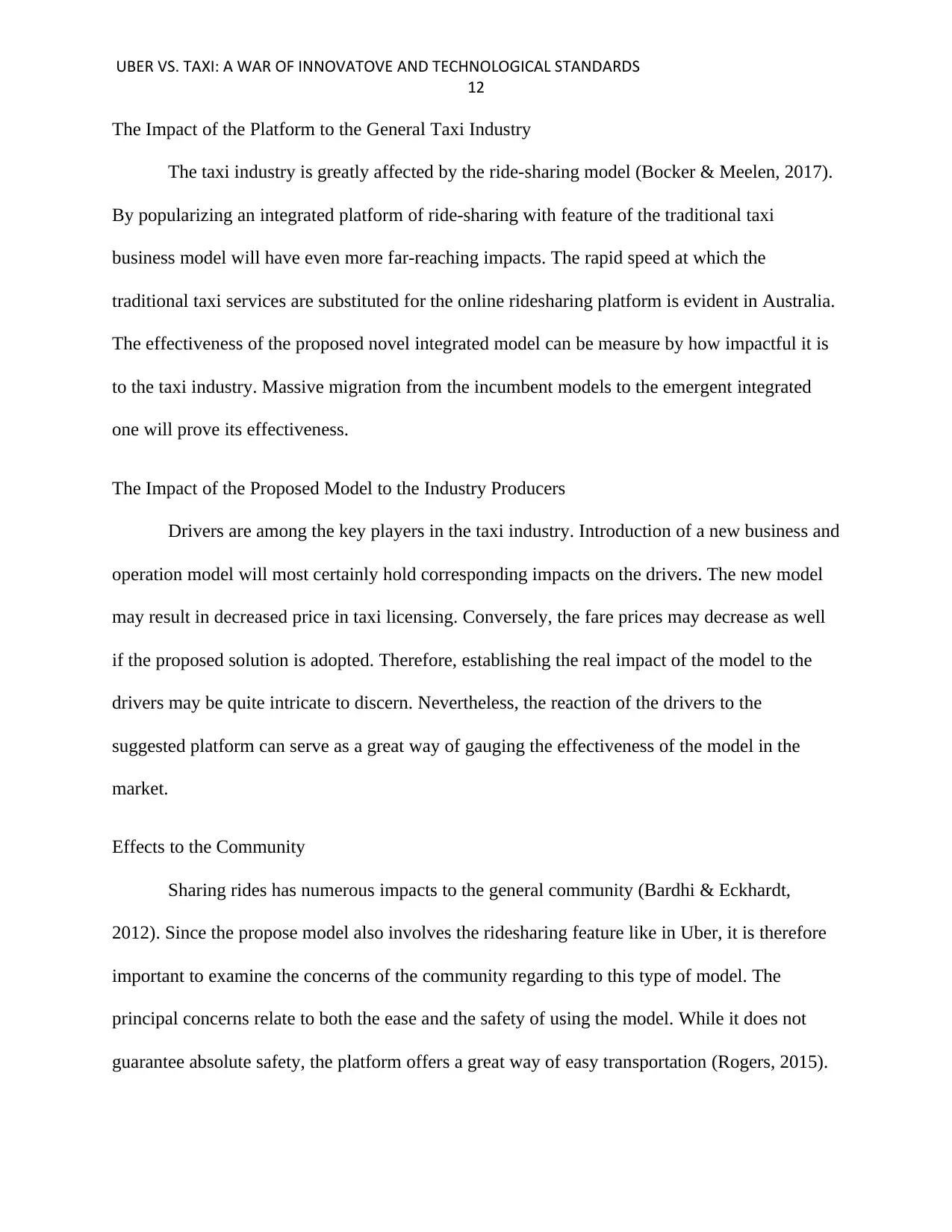
UBER VS. TAXI: A WAR OF INNOVATOVE AND TECHNOLOGICAL STANDARDS
12
The Impact of the Platform to the General Taxi Industry
The taxi industry is greatly affected by the ride-sharing model (Bocker & Meelen, 2017).
By popularizing an integrated platform of ride-sharing with feature of the traditional taxi
business model will have even more far-reaching impacts. The rapid speed at which the
traditional taxi services are substituted for the online ridesharing platform is evident in Australia.
The effectiveness of the proposed novel integrated model can be measure by how impactful it is
to the taxi industry. Massive migration from the incumbent models to the emergent integrated
one will prove its effectiveness.
The Impact of the Proposed Model to the Industry Producers
Drivers are among the key players in the taxi industry. Introduction of a new business and
operation model will most certainly hold corresponding impacts on the drivers. The new model
may result in decreased price in taxi licensing. Conversely, the fare prices may decrease as well
if the proposed solution is adopted. Therefore, establishing the real impact of the model to the
drivers may be quite intricate to discern. Nevertheless, the reaction of the drivers to the
suggested platform can serve as a great way of gauging the effectiveness of the model in the
market.
Effects to the Community
Sharing rides has numerous impacts to the general community (Bardhi & Eckhardt,
2012). Since the propose model also involves the ridesharing feature like in Uber, it is therefore
important to examine the concerns of the community regarding to this type of model. The
principal concerns relate to both the ease and the safety of using the model. While it does not
guarantee absolute safety, the platform offers a great way of easy transportation (Rogers, 2015).
12
The Impact of the Platform to the General Taxi Industry
The taxi industry is greatly affected by the ride-sharing model (Bocker & Meelen, 2017).
By popularizing an integrated platform of ride-sharing with feature of the traditional taxi
business model will have even more far-reaching impacts. The rapid speed at which the
traditional taxi services are substituted for the online ridesharing platform is evident in Australia.
The effectiveness of the proposed novel integrated model can be measure by how impactful it is
to the taxi industry. Massive migration from the incumbent models to the emergent integrated
one will prove its effectiveness.
The Impact of the Proposed Model to the Industry Producers
Drivers are among the key players in the taxi industry. Introduction of a new business and
operation model will most certainly hold corresponding impacts on the drivers. The new model
may result in decreased price in taxi licensing. Conversely, the fare prices may decrease as well
if the proposed solution is adopted. Therefore, establishing the real impact of the model to the
drivers may be quite intricate to discern. Nevertheless, the reaction of the drivers to the
suggested platform can serve as a great way of gauging the effectiveness of the model in the
market.
Effects to the Community
Sharing rides has numerous impacts to the general community (Bardhi & Eckhardt,
2012). Since the propose model also involves the ridesharing feature like in Uber, it is therefore
important to examine the concerns of the community regarding to this type of model. The
principal concerns relate to both the ease and the safety of using the model. While it does not
guarantee absolute safety, the platform offers a great way of easy transportation (Rogers, 2015).
⊘ This is a preview!⊘
Do you want full access?
Subscribe today to unlock all pages.

Trusted by 1+ million students worldwide
1 out of 17
Related Documents
Your All-in-One AI-Powered Toolkit for Academic Success.
+13062052269
info@desklib.com
Available 24*7 on WhatsApp / Email
![[object Object]](/_next/static/media/star-bottom.7253800d.svg)
Unlock your academic potential
Copyright © 2020–2025 A2Z Services. All Rights Reserved. Developed and managed by ZUCOL.





